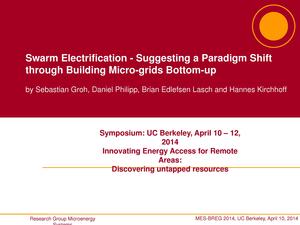Knowledge fuels change - Support energypedia!
For over 10 years, energypedia has been connecting energy experts around the world — helping them share knowledge, learn from each other, and accelerate the global energy transition.
Today, we ask for your support to keep this platform free and accessible to all.
Even a small contribution makes a big difference! If just 10–20% of our 60,000+ monthly visitors donated the equivalent of a cup of coffee — €5 — Energypedia would be fully funded for a whole year.
Is the knowledge you’ve gained through Energypedia this year worth €5 or more?
Your donation keeps the platform running, helps us create new knowledge products, and contributes directly to achieving SDG 7.
Thank you for your support, your donation, big or small, truly matters!
Swarm Electrification - Suggesting a Paradigm Shift through Building Microgrids Bottom-up
Swarm Electrification - Suggesting a Paradigm Shift through Building Microgrids Bottom-up
Presenter: Sebastian Groh, (Research Focus Microenery Systems, Technische Universität Berlin, Germany)
Rapporteur: Carmen Iten
Overview
| This paper outlines a bottom-up concept for micro-grids. It investigates how a grid can be build bottom-up in an economically sustainable way and how this approach relates to the current trend on micro-grids. A case study for Bangladesh illustrates the potential for building on the existing infrastructure of solar home systems and underlines the strength of the approach: it aims at economic and infrastructure development created from the communities themselves. Individual stand-alone energy systems are linked together to form a micro-grid that can expand towards and eventually interconnect with national or regional grids. This approach can be likened to the concept of swarm intelligence, where each individual node brings independent input to create a conglomerate of value even greater than the sum of its parts[1]. |
Issues Presented
► Please see the presentation.
- Bangladesh has a huge market but we don’t know that much about it. There is no data logging on the already installed systems. A simulation showed that there is a lot of energy access in systems (~40%).
- Communities get empowered by interconnectivity through microgrids. They have more bargaining power with big utilities and entrepreneurs can be a link.
- Sometimes there are up to 3 parallel grids in Bangladesh: the government grid which is unreliable, a microgrid, a DC- solar grid -> 2 type of switches and lights in houses
- Procumer: SHS owner can feed their excess energy into grid and eg. Make more money from it if there is a bad harvest by not using TV.
- Simulation: SHS is profitable after around 2 years. Swarm system is more investment than SHS in the beginning but you can also sell energy -> same as SHS for first 2 years, then better than SHS.
Q & A
- Institutional arrangement: Microgrid belongs to the people/community but we don’t know yet what happens during transition phase when the community gets connected to the grid. Example of transactions: Inensus in Senegal.
- Comparison to electrification of rural USA.
- Psychology: People like to have their own system. For a microgrid you need someone to “run the show” so that people trust it.
- Irrigation time is when people don’t use fans so they only need half of the electricity because no fans.
- For a microgrid the diversification of the consumer is important to get different load profiles.
References
- ↑ Swarm Electrification - Suggesting a Paradigm Shift through Building Microgrids Bottom-up Sebastian Groh, Daniel Philipp, Brian Edlefsen Lasch, Hannes Kirchhoff.





















